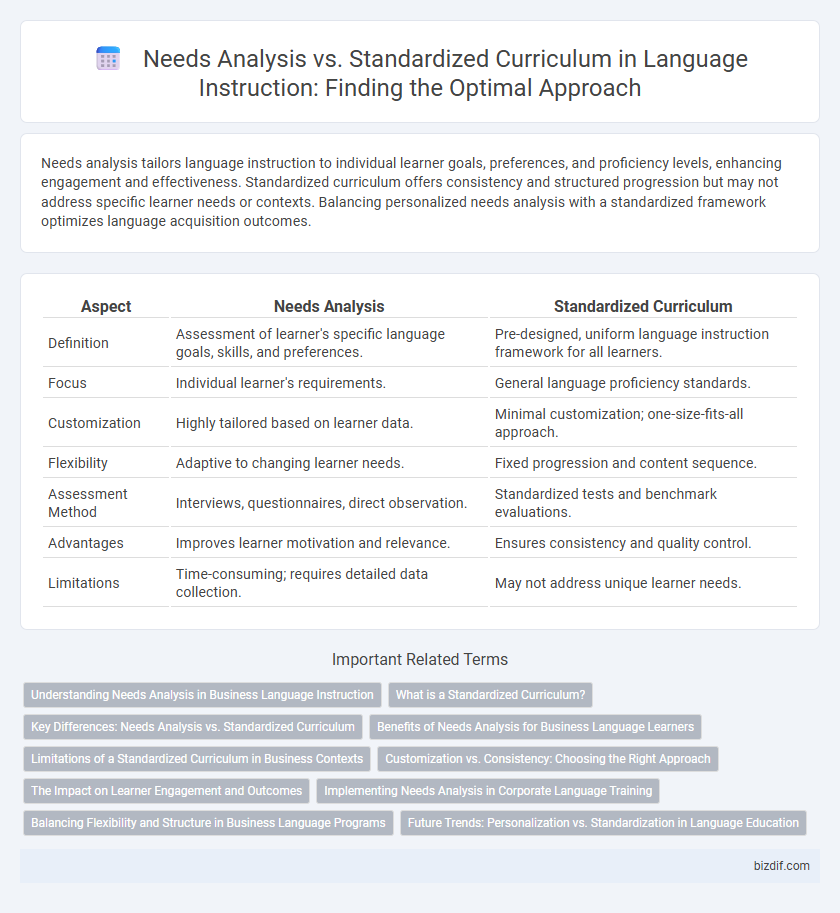Needs analysis tailors language instruction to individual learner goals, preferences, and proficiency levels, enhancing engagement and effectiveness. Standardized curriculum offers consistency and structured progression but may not address specific learner needs or contexts. Balancing personalized needs analysis with a standardized framework optimizes language acquisition outcomes.
Table of Comparison
| Aspect | Needs Analysis | Standardized Curriculum |
|---|---|---|
| Definition | Assessment of learner's specific language goals, skills, and preferences. | Pre-designed, uniform language instruction framework for all learners. |
| Focus | Individual learner's requirements. | General language proficiency standards. |
| Customization | Highly tailored based on learner data. | Minimal customization; one-size-fits-all approach. |
| Flexibility | Adaptive to changing learner needs. | Fixed progression and content sequence. |
| Assessment Method | Interviews, questionnaires, direct observation. | Standardized tests and benchmark evaluations. |
| Advantages | Improves learner motivation and relevance. | Ensures consistency and quality control. |
| Limitations | Time-consuming; requires detailed data collection. | May not address unique learner needs. |
Understanding Needs Analysis in Business Language Instruction
Needs analysis in business language instruction identifies specific learner goals, industry terminology, and communication challenges, ensuring tailored content that directly addresses workplace requirements. Unlike standardized curricula, which follow a fixed syllabus, needs analysis adapts lesson plans to reflect real-world business scenarios and organizational priorities. Effective needs analysis enhances learner engagement and skill application by aligning instruction with measurable performance outcomes and professional contexts.
What is a Standardized Curriculum?
A standardized curriculum refers to a fixed and uniform set of learning objectives, materials, and assessment methods applied consistently across all learners within a program or institution. It ensures comparability and systematic coverage of language skills but may lack customization to individual learner needs identified through needs analysis. This rigidity can limit responsiveness to diverse student goals, proficiency levels, and contextual factors crucial for effective language instruction.
Key Differences: Needs Analysis vs. Standardized Curriculum
Needs analysis tailors language instruction by evaluating learners' specific goals, backgrounds, and proficiency levels, ensuring personalized content that addresses real communication requirements. In contrast, standardized curriculum follows a predetermined structure with uniform objectives and materials designed for a broad audience, promoting consistency but often lacking customization. Key differences lie in flexibility and relevance, where needs analysis optimizes learner engagement and outcomes by adapting content, while standardized curriculum prioritizes scalability and ease of implementation.
Benefits of Needs Analysis for Business Language Learners
Needs analysis in business language instruction enables tailored learning experiences by identifying specific professional communication requirements, enhancing relevance and learner engagement. This personalized approach increases efficiency and retention by addressing unique vocabulary, cultural nuances, and industry-specific scenarios compared to standardized curricula. As a result, business language learners achieve practical skills directly applicable to real-world workplace situations, improving overall performance and career advancement opportunities.
Limitations of a Standardized Curriculum in Business Contexts
Standardized curricula often lack the flexibility to address specific learner needs, particularly in dynamic business contexts where industry demands frequently evolve. This rigidity can result in outdated or irrelevant content, reducing the effectiveness of language instruction for professionals requiring targeted communication skills. Customizing instruction based on thorough needs analysis ensures alignment with real-world business scenarios, fostering improved language proficiency and practical application.
Customization vs. Consistency: Choosing the Right Approach
Needs analysis in language instruction prioritizes customization by tailoring lessons to learners' unique goals, proficiency levels, and cultural backgrounds, thereby enhancing motivation and effectiveness. Conversely, a standardized curriculum ensures consistency by providing a structured framework with uniform content and assessment criteria, facilitating scalability and quality control across diverse settings. Educators must weigh the benefits of personalized learning pathways against the reliability of standardized programs to select the most appropriate approach for their specific teaching context.
The Impact on Learner Engagement and Outcomes
Needs analysis tailors language instruction to individual learner profiles, significantly boosting engagement by addressing specific goals, interests, and proficiency levels. Standardized curricula offer structured frameworks but may overlook unique learner needs, potentially leading to reduced motivation and suboptimal outcomes. Effective language programs balance tailored needs analysis with standardized elements to enhance learner engagement and maximize proficiency gains.
Implementing Needs Analysis in Corporate Language Training
Implementing needs analysis in corporate language training enables tailored instruction that directly addresses employee proficiency gaps and organizational goals. This approach contrasts with standardized curriculum models by prioritizing specific communication tasks and role-based language skills, enhancing training relevance and learner engagement. Data-driven needs analysis ensures resource optimization and measurable outcomes aligned with business performance indicators.
Balancing Flexibility and Structure in Business Language Programs
Effective business language programs balance flexibility and structure by integrating needs analysis with standardized curriculum components. Needs analysis tailors instruction to specific learner goals and industry demands, enhancing relevance and engagement. Standardized curricula provide consistent frameworks and measurable outcomes, ensuring comprehensive skill development across diverse learner populations.
Future Trends: Personalization vs. Standardization in Language Education
Needs analysis enables language educators to tailor instruction based on individual learner profiles, promoting personalized pathways that improve engagement and outcomes. Standardized curricula provide structured frameworks ensuring consistency and scalability across diverse learning environments. Future trends in language education emphasize a dynamic balance where adaptive technologies and data-driven insights enhance personalized learning while maintaining core standardized benchmarks for proficiency and assessment.
Needs analysis vs Standardized curriculum Infographic

 bizdif.com
bizdif.com